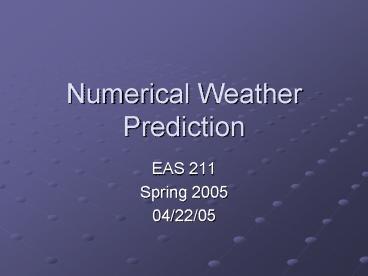Numerical Weather Prediction PowerPoint PPT Presentation
1 / 15
Title: Numerical Weather Prediction
1
Numerical Weather Prediction
- EAS 211
- Spring 2005
- 04/22/05
2
NWP
- Computer models, numerical models attempt to
predict the weather using 7 fundamental equations
that govern how the basic parameters change in
the atmosphere with time. - The study of how we can physically and
mathematically represent processes in the
atmosphere is known as dynamics.
3
Computer models cannot perfectly predict the
weather, obviously, but what makes them
inaccurate?
- Errors.
- Initial conditions
- Intrinsic to the model
- Errors perpetuate with time and the model becomes
less and less accurate. - Parameterizations.
- Methods for dealing with physical processes that
are too small to include in the model.
4
Why do we need parameterizations? How can a
process be too small?
- Planetary, synoptic, meso, and micro (or storm)
scales - The model equations used in the model are only
used for one scale, so we eliminate all other
scales. - But often, the scales we eliminate are large
contributors to the scale we are examining. - Smaller scale motions not captured by the surface
or upper air observing networks are still
important to the larger scale. - So we parameterize the effects of the smaller
scale on the larger scale.
5
What is parameterized?
- Convection
- MicrophysicsMoisture
- Turbulence
- Soil Moisture
- Radiation
6
WE NEED BETTER OBS.
- Improvements in the density of our surface and
upper air observing networks to better capture
the small scale motions would lead to improvement
in the model results.
7
Current NWP models
- Run daily at the National Center for
Environmental Prediction (NCEP) - NGM
- ETA
- AVN
- ECMWF
- RUC
- MM5
- WRF
- GFS
- NAM
8
NCEP Models
- NGMNested Grid Model
- 80 km
- Grid point model, meaning obs are converted to
values at various points that are evenly spaced
so the computer program can plug them into
equations. - Frozen model.
- Being phased out.
9
NCEP models
- Eta
- Doesnt stand for anything.
- Grid point model using either a 22 or 12 km grid.
- Accounts for changes in terrain as a series of
steps each of which corresponds to a level of the
models vertical coordinate, eta. (Eta is
analogous to pressure). - NAM North American Mesoscale Model
10
NCEP models
- AVN, MRF, GSM
- Global-spectral models
- Converts data into a large number of mathematical
waves which the model uses for its calculations
and then returns the waves in a manner that will
produce a forecast map. - These models go out farther in time than the
regional models. - AVN-160 hours
11
NCEP Models
- ECMWF (European Center for Medium-Range Weather
Forecasts) and Canadian - Spectral models used for medium range forecasts
(7-10 days) - Considered by many to be the most advanced model
in the world.
12
NCEP Models
- MM5Mesoscale Meteorological Model Version 5.
Penn. State and NCAR. - WRFWeather Research and Forecasting Model (NCAR)
- MM5 is designed to run on the mesoscale.
- MM5 and WRF are primarily used for research
purposed, but there are some available MM5 and
WRF models running throughout the US.
13
Ensemble Predictions
- Method uses a collection of two or more forecasts
for the same time. These forecasts either use
different initial conditions or are based on
different forecasting procedures. - The various forecasts represent possibilities of
how the weather might change in the future. - An estimate of the probabilities of various
events as well as an average (consensus)
forecast. - This means if several forecasts all give the same
result, this result is more likely to occur, we
have more confidence in our forecast.
14
Advice on NWP
- Models should not be used without first
consulting the observed data and applying
knowledge of atmospheric processes to determine a
forecast. - To use only model data is to succumb to what is
called meteorological cancer - Try to use your time wisely when creating a
forecast rather than trying to determine which
model to use. You will find that no model will
predict as well as an experienced, knowledgeable
human forecaster.
15
Information on Models
- NCEP
- http//www.ncep.noaa.gov

